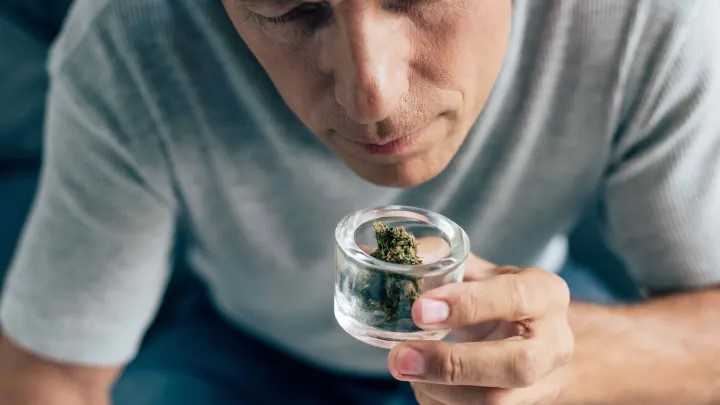 £0 0 item
£0 0 item 
Published: 22-09-2021
The collective components of marijuana play a role in your overall experience. Amongst these components includes its smell. Whether you smoke it or add it to your favorite chocolate brownie recipe, the smell of your marijuana determines how you will enjoy this experience. Thus, it’s a good idea to find out what does marijuana smells like?

Generally, maturity affects the smell of marijuana. Marijuana from a younger plant has a milder smell. However, when smoked, the smell has a more intense odor. Marijuana from an older plant has a relatively strong but not so pungent smell.
Primarily, the smell of marijuana is determined by compounds known as terpenes. Terpenes refer to volatile unsaturated hydrocarbons found in many plants and trees. Typically, they are found in essential oils extracted from plants and trees. You can find them in various plants and trees such as lemons, lavender, rosemary, and rose.
Terpenes are responsible for giving these essential oils and plant their characteristic smell. In fact, manufacturers isolate terpenes to give products such as perfumes and lotions their characteristic scents. The same principle applies to marijuana. Different strains incorporate different terpenes that determine their characteristic smell. Common terpenes in the marijuana plant include myrcene, limonene, and linalool.
An abundant cannabis terpene, myrcene content in the marijuana plant covers more than 60% of the terpene profile. It offers earthy, musky notes with a faint red grape note. This probably explains why natural cannabis strains have an earthy note. On the other hand, limonene is found in some strains and accounts for their citrusy profile. Linalool gives a somewhat spicy and floral profile, similar to lavender and mint.
To the untrained nose, cannabis tends to give off strong earthy notes. However, with close examinations, you will notice other notes in the plant. Cannabis exudes earthy, spicy, woody, herbal, peppery, citrus, musky, and tropical notes.
Marijuana plants have the same all-around earthy smell. Generally, plants have the same smell during growth through harvest. The only difference is the intensity of the smell as the plant continues to mature. Mature plants have a much stronger smell than younger marijuana plants. The smell is most potent amongst plants with blossomed flowers.
When purchasing weed, you have to ensure you buy the best quality. After all, quality affects your overall experience. Good quality weed has a distinctive green color appearance and tends to be a little moist. Don't go for weed that is too moist as it offers the perfect environment for bacteria mold!
In this state, weed typically has a stronger smell compared to dry plants. Depending on the strain, weed has a somewhat woody, herbal, and earthy scent profile during purchase. In addition to this base profile, the strain will also determine additional booster notes. These include notes of lemon and berries.
When you first start to smoke weed, you will smell the faint earthy and fresh notes. Remember, most cannabis strains have more than 60% myrcene as part of their terpene content. Thus, myrcene is primarily responsible for its earthy, herbal, and aromatic smell. Think scent profile of herbs such as thyme and basil. Both these herbs contain a significant amount of myrcene.

However, when it’s burning, you have to consider the multiple components it combines. Think of components such as the weed itself, smoke from the burning fire, the ash, and of course, the joint paper.
Ultimately, when you smoke weed, it clings to your skin, clothes, and hair. Thus, once you finish smoking, you will have a whole new smell around you. This scent also combines with your body odor, such as sweat, to create its own foul, earthy, and smoky odor.
Also known as K2, skunk, bliss, or Mamba, synthetic weed refers to laboratory-produced weed. This doesn't necessarily mean they are grown in the lab. Instead, it is produced by mixing different chemical components and doesn’t include any part of the actual marijuana plant. However, since its production isn’t regulated, there’s no standard smell for synthetic weed. Instead, it is typically marketed based on the manufacturer’s sole discretion.
Indica and Sativa are the two primary cannabis strains. Sativa strains contain high limonene terpene content that helps to uplift your mood. This makes it a perfect marijuana strain to smoke during the day when you want to enjoy more focus, attention, and creativity.
On the other hand, Indica strain serves users who want to feel relaxed, euphoric, and sleep but happy. It is known as the nighttime strain. Sativa strains have a spicy or sweet scent profile, while Indica strains have a sour, sharp, or pungent scent profile.
While these strains have primary terpenes such as limonene, they also have additional minor terpenes depending on the strain and blend. Combined, these terpenes give the strains their characteristic smell. Additionally, many cannabis growers tend to mix different Indica and Sativa strains to create various hybrid strains. These strains have their own scent profile too.
The bottom line is that natural marijuana contains the same scent profile from the growth to the consumption phase. For the most part, good-quality marijuana boasts an earthy, herbal, and wood smell. However, you also have to remember the different strains. Sativa strain has a sweet or spicy profile, while the Indica has a pungent, sour, or sharp scent profile.
However, with the increase of hybrid strains, you can find numerous scent variations with notes of lemon, apple, spice, and many more. Nonetheless, the base smell always remains to be earthy!
